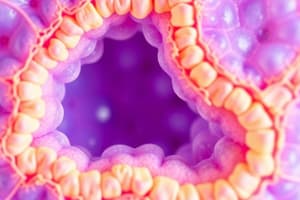Podcast
Questions and Answers
What are the two main types of nerve cells?
What are the two main types of nerve cells?
- Sensory cells and motor cells
- Meninges and myelin
- Neurons and glia (correct)
- Dendrites and axons
What type of tissue is specialized for the rapid conduction of electrical impulses?
What type of tissue is specialized for the rapid conduction of electrical impulses?
- Epithelial tissue
- Muscle tissue
- Connective tissue
- Nervous tissue (correct)
What is the function of dendrites in neurons?
What is the function of dendrites in neurons?
- Receive sensory information (correct)
- Support cell functions
- Insulate the axon
- Transmit impulses away from the cell body
Which part of the nervous system has a protective covering called meninges?
Which part of the nervous system has a protective covering called meninges?
What is the myelin sheath's primary role in nerve function?
What is the myelin sheath's primary role in nerve function?
Which type of organ is vital for an organism's survival?
Which type of organ is vital for an organism's survival?
How are organs classified in relation to their functions?
How are organs classified in relation to their functions?
Which of the following statements about non-vital organs is true?
Which of the following statements about non-vital organs is true?
What is the primary characteristic of a system in the human body?
What is the primary characteristic of a system in the human body?
Which of the following is NOT considered a major body system?
Which of the following is NOT considered a major body system?
What does the term 'supine' refer to in anatomical positioning?
What does the term 'supine' refer to in anatomical positioning?
Which system is responsible for immune responses in the body?
Which system is responsible for immune responses in the body?
How many major body systems are there in total?
How many major body systems are there in total?
What position describes the body lying face down?
What position describes the body lying face down?
Which of the following systems is involved in the production of hormones?
Which of the following systems is involved in the production of hormones?
How are body systems described according to their functions?
How are body systems described according to their functions?
What term is used to describe cells that are flat or scale-like?
What term is used to describe cells that are flat or scale-like?
Which type of epithelial tissue consists of a single layer of cube-shaped cells?
Which type of epithelial tissue consists of a single layer of cube-shaped cells?
Which type of epithelium is named for having multiple layers of flattened cells?
Which type of epithelium is named for having multiple layers of flattened cells?
Which type of epithelial tissue has cells that can change shape and is found in areas requiring stretch?
Which type of epithelial tissue has cells that can change shape and is found in areas requiring stretch?
What arrangement is characteristic of simple columnar epithelium?
What arrangement is characteristic of simple columnar epithelium?
How are stratified cuboidal epithelium characterized in terms of layers?
How are stratified cuboidal epithelium characterized in terms of layers?
What arrangement is represented by simple squamous epithelium?
What arrangement is represented by simple squamous epithelium?
What characterizes pseudostratified columnar epithelium?
What characterizes pseudostratified columnar epithelium?
Which of the following functions is NOT performed by epithelial tissues?
Which of the following functions is NOT performed by epithelial tissues?
Which type of epithelial tissue consists of several layers of either columnar or cuboidal shapes?
Which type of epithelial tissue consists of several layers of either columnar or cuboidal shapes?
Transitional epithelium is primarily known for its ability to:
Transitional epithelium is primarily known for its ability to:
Which type of epithelium is specialized for secretion?
Which type of epithelium is specialized for secretion?
What is a function of epithelial tissues related to the kidneys?
What is a function of epithelial tissues related to the kidneys?
Which of the following statements is true regarding epithelial tissue?
Which of the following statements is true regarding epithelial tissue?
Which characteristic does NOT describe glandular epithelium?
Which characteristic does NOT describe glandular epithelium?
Epithelial tissues include which of the following functions?
Epithelial tissues include which of the following functions?
What is formed when similar cells organize together?
What is formed when similar cells organize together?
Which type of tissue is responsible for covering body surfaces and lining internal organs?
Which type of tissue is responsible for covering body surfaces and lining internal organs?
What is the correct sequence of organization from cells to organisms?
What is the correct sequence of organization from cells to organisms?
How many main types of tissues are there in the human body?
How many main types of tissues are there in the human body?
Which statement correctly describes organs in relation to tissues?
Which statement correctly describes organs in relation to tissues?
Which of the following tissues is known for its ability to contract and aid in movement?
Which of the following tissues is known for its ability to contract and aid in movement?
What forms when multiple organs work together for a specific activity?
What forms when multiple organs work together for a specific activity?
Which type of tissue primarily functions to connect different parts of the body?
Which type of tissue primarily functions to connect different parts of the body?
Flashcards are hidden until you start studying
Study Notes
Tissues
- Tissues are formed when similar cells with similar functions come together.
- There are four main tissue types: epithelial, connective, muscle, and nervous.
Epithelial Tissues
- Cover surfaces, line internal organs and make up glands.
- Cells are closely linked, forming a sheet-like structure.
- Classified based on cell shape:
- Squamous (flat and scale-like)
- Cuboidal (cube-shaped)
- Columnar (column-like)
- Transitional (stretchy and variable in shape)
- Classified by cell arrangement:
- Simple squamous: Single layer of flattened cells, nuclei are flattened discs.
- Simple cuboidal: Single layer of cube-shaped cells, round nuclei.
- Simple columnar: Single layer of elongated cells, elongated nuclei.
- Stratified squamous: Multiple layers of same cell type, flatten as they move outwards.
- Stratified cuboidal: 2-3 layers of cubed cells.
- Stratified columnar: Multiple layers of columnar or cubed cells.
- Pseudostratified columnar: Single cell layer, appears layered because nuclei are at different levels.
- Transitional: Changes appearance based on tension.
- Glandular: Specialized cells, produce and secrete substances into ducts or body fluids, found in glands.
- Functions:
- Physical protection (against external and internal abrasion)
- Absorption (intestinal absorption)
- Filtration (tracheal filtration)
- Excretion (renal excretion, sweating)
- Sensation (ear, skin, nose, tongue sensation)
- Specialized secretion (hormones, enzymes)
- Permeability (kidneys, lungs)
Connective Tissues
- Most common tissue type.
- Found in organs, bones, nerves, muscles, and skin.
Studying That Suits You
Use AI to generate personalized quizzes and flashcards to suit your learning preferences.




